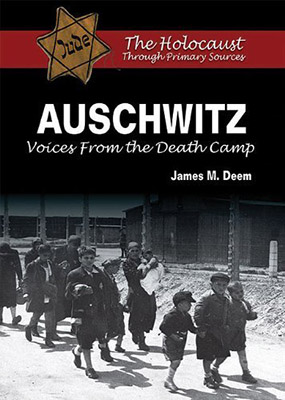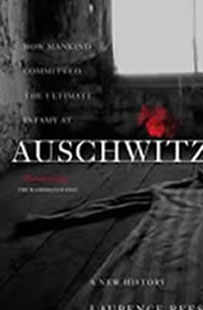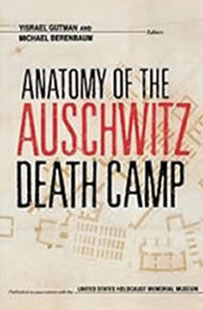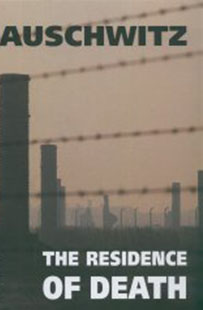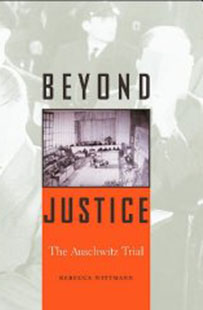Paperback edition, 2012. |
~~ Excerpt ~~ Teacher's Guide ~~ ~~ Suggestions for Visiting Auschwitz ~~ ~~ Related Books by James M Deem: The Prisoners of Breendonk ~~ Kristallnacht ~~ |
Auschwitz: Voices from the Death Camp examines the largest death camp of the Holocaust. It discusses the beginning of Oświęcim as a Polish military camp before Poland was invaded by the Germans in 1939 and outlines the construction and organization of the camp as it expanded under the Nazi regime: Auschwitz I (the administrative center), Auschwitz II-Birkenau (the Death Camp with its multiple gas chambers and crematoria), and Auschwitz III (the affiliated slave labor camps).
The book features ten true accounts from prisoners of the camp and Nazi perpetrators:
Chapter 1. Kazimierz Albin (one of the first Polish prisoners)
On his arrival at Auschwitz: "We saw extended lines of armed SS-men on either side of the track. The carriage doors were thrown open. . . . Our escorts, who up until now had been relatively calm, suddenly started on us as if possessed. Using their rifle butts, they shoved us out of the carriage and, amid ear-splitting shouts, drove us through a gate into a large square surrounded by a thick barbed-wire fence. At every corner, perched on tall wooden beams, was a watchtower with a machine gun manned by SS-men."
Chapter 2. Rudolf Höss (the camp commandant)
On ordering the death of a fellow Nazi: "The condemned man was a decent person in his middle thirties, married with three children, who had been conscientious and loyal in his duties. . . . He went to his death calm and collected. To this day I still cannot understand how I could have calmly given the order to fire...."
Chapter 3. Pery Broad (a camp official)
On conditions at Birkenau: "Feet sank into a sticky bog at every step. There was hardly any water for washing. The prisoners slept, six to a bed, on wooden planks placed in three tiers. Most of the beds were without straw pallets. The roll call held twice daily meant standing for hours in wet and cold weather with mire underfoot. If it rained in the daytime, the prisoners would be obliged to lie on the beds in their wet clothes. No wonder that several hundred of them died every day...."
Chapter 4. Andrey Pogozhev (a Russian POW)
On his arrival at Auschwitz: "Our first days in Auschwitz dumbfounded us. They transformed us from human beings into a herd of animals. . . . Everyone had to be present for roll-call. Sick men . . . even dead men . . . would be brought out from the blocks...."
Chapter 5. Walter Winter (a Roma prisoner)
On summarizing his feelings about Auschwitz: "In books you read: [Auschwitz] was like this, and this. The authors always write that so and so many people were murdered and that the people were maltreated. That is correct, that is all true, but you don’t read about the feelings, the constant fear. There are things that people cannot begin to comprehend...."
Chapter 6. Dr. Miklos Nyiszli (a prisoner forced to work for Dr. Mengele)
On his life after Auschwitz: "I knew it would take much time and infinite patience before we could resume any sort of really normal life. But all that mattered was that we were alive . . . and together again. Life suddenly became meaningful again...."
Chapter 7. Shlomo Dragon (a prisoner forced to work in the Sonderkommando)
On trying to escape from Nazi guards during the death march: "As I marched, I suddenly saw a path that broke away from the main road and led to a village. . . . I told my brother, 'Abraham, I’m going down that path, even if I get shot. I want to escape.' It was obvious to me that the Germans would shoot at me . . . but I was determined to try. . . ."
Chapter 8. Anna Heilman (a prisoner whose sister participated in the 1944 uprising)
On remembering a dream about bread during her first night at Auschwitz: "Slowly my eyes close. I see a whole golden loaf of bread. . . . I grab it with both my hands to sink my teeth into it, when the shrill of the whistle wakes me up. I close my eyes to see my treasure once more, but my dream has flitted away...."
Chapter 9. Primo Levi (a prisoner who became a famous writer)
On the meaning of food at Auschwitz: "We have learnt the value of food; now we also diligently scrape the bottom of the bowl after the ration and we hold it under our chins when we eat bread so as not to lose the crumbs. . . ."
Chapter 10. Éva Heyman (a prisoner who left behind a diary)
On the deportation of Hungarian Jews to Auschwitz: "They forced 80 people in freight cars and they gave them altogether only one bucket of drinking water. But it is still more awful that they are sealing the cars with padlocks...."
Honors and Reviews
Selected as one of Pennsylvania State Library Association's Top 40 (or so) 2012 Titles
Pennsylvania State Library Association
"Using prisoners’ personal accounts, James Deem details the horrors of the German death camp Auschwitz. Beginning with an introduction on the construction and expansion of the camp, each chapter focuses on an individual’s experience in the camp. This searing account concludes with an entry on visiting Auschwitz today and its emotional impact on the author. Well-chosen photos, chapter notes, glossary, additional resources, and index add value to this important book. Highly recommended for all middle school and high school libraries."
TriState Reviews
"The book is both exceptionally well written and exciting. The book is remarkably nonjudgmental, non-sensationalized, and compassionately objective in its presentation of information. Each chapter offers the personal narratives of several of the active participants: Jewish, Polish, Gypsy prisoners, Soviet POWs, and Nazi officials and guards. First person accounts are presented in cursive script and discuss events, experiences, and outcomes. They share their feelings, fears and memories of Auschwitz and how their “selection” was made.... This is a must purchase for any library."
Christian Library Journal
"The narrative, which is nonjudgmental and non-sensationalized, includes true accounts from prisoners of the camp.... What sets Auschwitz by Deem apart from other titles is the view it provides in looking at this unspeakable horror through the eyes of survivors who had to watch those around them suffer and perish."
Reading Robin Blog
"A well-researched account of the Nazi concentration camp, Auschwitz, based on eyewitness accounts.... It does not contain the gruesome photos that many books on the Holocaust do, but that does not make these stories any less horrifying. There are photos of the camps, the gas chambers, maps of the grounds, and more, where more than 1.1 million people met their deaths. One of the most intriguing and awful stories comes from Dr. Miklos Nyiszli, a Jewish doctor forced to work for the notorious Dr. Josef Mengele; I cannot imagine the unspeakable things this guy had to see and was forced to do to his own people. I even learned a few facts I had never heard of before–like the Nazi’s harvesting thousands of pounds of hair from the prisoners and shipping it off to make textiles (including uniforms) for the German army. *shudder*
"This is a great book for gaining general knowledge about the Holocaust, particularly the concentration camps, and would be a wonderful resource for researchers, because of all the primary sources. It lends invaluable insight into the terror that was Auschwitz. I recommend for grades 10 and up."
Denver Public Schools
"This approach and format is much more extensive and personal than most Holocaust books for this age group, and will appeal to those who crave more depth and understanding."
Delaware County Library System
". . . a very useful source for research, and compelling reading for anyone interested in resistance movements and World War II and Holocaust history."
